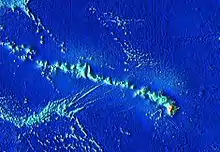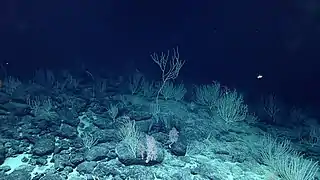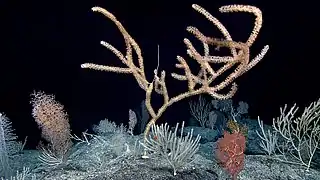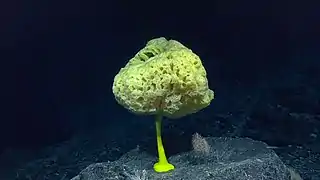Musicians Seamounts
Musicians Seamounts are a chain of seamounts in the Pacific Ocean, north of the Hawaiian Ridge. There are about 65 seamounts, some of which are named after musicians. These seamounts exist in two chains, one of which has been attributed to a probably now-extinct hotspot called the Euterpe hotspot. Others may have formed in response to plate tectonics associated with the boundary between the Pacific Plate and the former Farallon Plate.

The seamounts were constructed on young oceanic crust during the Cretaceous, but a second phase of volcanic activity took place during the Eocene. Deep sea coral reefs occur on the seamounts.
Geography and geomorphology
The Musicians Seamounts lie in the north-central Pacific,[2][3] north of the Hawaiian Ridge north and northwest of Necker Island,[4] extending over a length of 1,200 kilometres (750 mi).[5] The seamounts were formerly known as the North Hawaiian Seamount Range[6] and were among the first submarine mountains to be thoroughly researched.[7]

The seamounts consist of two separate chains (one trending in north-south direction parallel to the Emperor Seamounts and the other in northwest-southeast direction parallel to the northern Line Islands) of ridges that extend east-west and seamounts.[3] Seamounts have usually an elliptical cross section and heights of 1,000–4,000 metres (3,300–13,100 ft)[2] and no flat tops like other seamounts south of the Hawaiian Ridge; the highest is Liszt Seamount whose summit has a depth of 1,582 metres (5,190 ft).[8] The ridges contain individual volcanoes and reach lengths of over 400 kilometres (250 mi); in the Italian[lower-alpha 1] and Bach Ridges the volcanoes are 2.2–5.1 kilometres (1.4–3.2 mi) high. The Musicians horst and the Southern Ridges are additional features of the Musicians Seamounts.[1] Terrain observed by remotely operated vehicles shows large blocks, pillow lavas, flat terrain, lava flows and talus.[10]
The total number of seamounts is about 65,[5] some of which Henry William Menard named after 18th century musicians.[11] Among the seamounts known by name are:[12][4][13][14]
- The "Northwest Cluster"
- Rossini (32°12′N 163°00′W[15])
- Bizet (32.26°N 161.63°W[16])
- Godard (31.48°N 164.56°W[16])
- Wagner (31°46′N 162°54′W[15])
- Shostakovich (33°16′N 164°53′W[15])
- Strauss (33°18′N 164°09′W[15])
- Bellini (32°42′N 163°11′W[15])
- Verdi (31.60°N 162.90°W[16])
- Puccini (32°15′N 162°21′W[15])
- Schubert (31.90°N 162.10°W[16])
- Donizetti (32.33°N 160.00°W[16])
- Hammerstein (32.46°N 165.76°W[16])
- Mahler (31.60°N 165.00°W[16])
- Brahms (31.15°N 162.31°W[16])
- Mussorgski (30°22′N 163°50′W[15])
- Debussy (30.30°N 162.09°W[16])
- Dvorak (30°31′N 161°20′W[15])
- Rachmaninoff (29°35′16.6″N 163°21′0.6″W[15])
- Tchaikovsky (29.39°N 162.09°W[16])
- Liszt (29.00°N 162.00°W[16])
- Paganini (28°41′N 162°40′W[15])
- Mozart (28°40′N 161°43′W[15])
- Khachaturian (28°8′27.9″N 162°18′54.6″W[15])
- Grieg (27°51′N 162°03′W[15])
- Gounod (27°53′N 161°20′W[15])
- Handel (27.50°N 159.80°W[16])
- Scarlatti (27°38′5.7″N 160°14′10.5″W[15])
- Ravel (27°16′N 161°40′W[15])
- Gluck (26°53′N 160°06′W[15])
- Sibelius (27°13′N 160°44′W[15])
- Chopin (26.10°N 162.00°W[16])
- Haydn (26.67°N 161.20°W[16])
- Bach Ridge (26.50°N 158.40°W[16])
- West Schumann
- West Mendelssohn
- East Mendelssohn
- Prokofiev (25°51′N 157°53′W[15])
- Paumakua (24.83°N 157.08°W[16]).
Geology
The Pacific Ocean floor beneath the seamounts is of Cretaceous age and is subdivided by the Murray Fracture Zone into an older northern (100 to 95 million years ago) and a younger southern (80 to 85 million years ago) sector.[3] To the north, the Musicians Seamounts are limited by the Pioneer Fracture Zone.[17] The Musicians Seamounts developed on crust that was no more than 20 million years old,[3] and paleomagnetic information indicates that the seamounts were located between 0 and 10° north of the equator when they developed.[18]
Rock samples dredged from the seamounts include basalt, hawaiite, mugearite and trachyte. Minerals contained in the rocks consist of aegirine, augite, clinopyroxene, feldspar, oxidized olivine, orthopyroxene, plagioclase and pyroxene. Calcite, clay and zeolites have formed through alteration processes,[19] and manganese nodules have been encountered as well.[20] The petrogenesis of Musicians Seamounts magmas has been explained by the mixing of several mantle-derived components.[21]
Origin
The origin of the seamounts has been explained with either one or two hotspots of Cretaceous age.[3] Dating of the seamounts supports a hotspot origin only for the northwest-southeast trend, however.[18] This hotspot has been named Euterpe hotspot after Euterpe, Greek Muse of musicians.[1] Plate reconstructions for the time period based on the dates of the northwest-southeast trend and the older Line Islands are consistent with each other.[22]
It is possible that their formation was influenced by the nearby presence of a spreading ridge,[23] a process which has been suggested for other hotspots such as Réunion, Iceland, Azores and others as well.[24] The Farallon Plate-Pacific Plate spreading ridge was located east of the Musicians Seamounts and flow from the hotspot to the ridge may have generated the east-west trending ridges of the Musicians Seamounts.[1]
Alternative explanations for the formation of the Musicians Seamounts is the presence of a former spreading ridge at their site,[17] and crustal weaknesses associated with the so-called "bending line" in the region which was formed by a change in the motion of the Pacific Plate.[25]
Geologic context
About 10,000 seamounts and islands are estimated to dot the floor of the Pacific Ocean, forming clusters and chains.[26] The origin of chains of seamounts and islands is commonly explained with the hotspot hypothesis, which posits that as the crust migrates above a stationary hotspot volcanism forms these structures. A further hypothesis states that the hotspots, sourced from mantle plumes, are static with respect to each other and thus geologists can reconstruct the history of plate movement by analyzing the tracks traced on the crust by hotspots.[27]
The Pacific Ocean contains a number of seamount and island chains,[27] some of which have been attributed to hotspots such as the Cobb hotspot, Caroline hotspot, Hawaiian hotspot, Marquesas hotspot, Tahiti hotspot, Pitcairn hotspot, Macdonald hotspot and Louisville hotspot.[3] Not all of these hotspots are necessarily fed by a deep continuous mantle plume; some may be nourished by discrete batches of melting material that rise through the mantle.[23] Other chains may be controlled by mantle flow towards a spreading ridge, which has been proposed for the Musicians chain.[28]
Biology
Deep sea corals and sponges grow on the Musicians Seamounts;[29] corals identified include Antipathes, Acanthogorgia, chrysogorgidae, Hemicorallium, isididae, Metalagorgia, Paracalyptrophora, Pleurogorgia and primnoids, while sponges include Caulophacus, Hyalostylus, Poliopogon and Saccocalyx. In some places true "coral forests" grow on the seamounts. Animal species observed on the seamounts by remotely operated vehicles include amphipods, anemones, anglerfish, arrow worms, bristlemouths, brittle stars, cephalopods, chirons, codling fish, ctenophores, crinoids, cusk eels, fangtooth fish, halosaurs, jellyfish, larvaceans, piglet squid, polychaetes, ribbon worms, sea cucumbers, sea elephants, sea pens, sea spiders, sea stars, shrimp, siphonophores, spider crabs, squat lobsters, urchins and zoanthids.[10]
Eruptive history
The Musicians Seamounts were active during the Late Cretaceous.[3] Ages obtained on some seamounts range from 96 million years ago for the Northwest Cluster over 94 million years ago for Hammerstein, 91 million years ago for Mahler, 90 million years ago for Brahms, 86 million years ago for Rachmaninoff, 84 million years ago for Liszt, 83 million years ago for Khatchaturian and West Schumann, 82 million years ago for West Mendelssohn, 79 million years ago for East Mendelssohn, 75 million years ago for Bach Ridge and Haydn to 65 million years ago for Paumakua.[12]
Based on considerations derived from plate tectonics, earlier volcanism could have occurred on the Farallon Plate,[1] which has been subducted in its entirely and its volcanoes have now vanished.[30] No volcanism in the Musicians Seamounts post-dating about 70 million years ago was discovered at first;[18] either volcanism ceased at that time or it continued on the Farallon Plate again.[23] The Euterpe hotspot is now extinct,[lower-alpha 2][1] although an unusually shallow ocean region around 0°S 148°W may be a remnant of the Euterpe hotspot.[31]
Some of the ridges in the Musicians Seamounts have much younger ages, 53 to 52 million years ago by argon-argon dating[32] and continuing to 48 to 47 million years ago.[33] This volcanism occurred at the time of major changes in the motion of the Pacific Plate; stresses occurring within the plate may have reactivated the Musicians volcanoes and resulted in this late stage activity.[34] One earthquake has been recorded in the province during historical time.[35]
See also
Notes
- In the northeasternmost Musicians Seamounts.[9]
- If the hotspot was still active, it would be located at 10°S 124°W.[1]
References
- Chuanshun et al. 2008, p. 460.
- Freedman & Parsons 1986, p. 8326.
- Pringle 1993, p. 188.
- Clague & Dalrymple 1975, p. 306.
- Rea & Naugler 1971, p. 89.
- Rea & Naugler 1971, p. 90.
- Kvile, Kristina Ø.; Taranto, Gerald H.; Pitcher, Tony J.; Morato, Telmo (May 2014). "A global assessment of seamount ecosystems knowledge using an ecosystem evaluation framework". Biological Conservation. 173: 117. doi:10.1016/j.biocon.2013.10.002. ISSN 0006-3207.
- Rea & Naugler 1971, p. 91.
- Watts, Anthony B. (2010). Treatise on Geophysics, Volume 6: Crust and Lithosphere Dynamics. Elsevier. p. 40. ISBN 9780444535726.
- "Daily Updates". Okeanos Explorer. NOAA. Retrieved 18 March 2018.
- "Marine Gazetteer Placedetails: Musicians Seamounts". Marine Regions. Flanders Marine Institute. Retrieved 18 March 2018.
- Pringle 1993, p. 189.
- Dixon, T. H.; Naraghi, M.; McNutt, M. K.; Smith, S. M. (1983). "Bathymetric prediction from SEASAT altimeter data". Journal of Geophysical Research. 88 (C3): 1563. Bibcode:1983JGR....88.1563D. doi:10.1029/jc088ic03p01563.
- Freedman & Parsons 1986, p. 8328.
- "Marine Gazetteer geographic name search". Marine Regions. Flanders Marine Institute. Retrieved 18 March 2018.
- Freymueller, Jeffrey T.; Kellogg, James N. (1992). Isostasy and Tectonic Origins of Pacific Seamounts. Geology and Offshore Mineral Resources of the Central Pacific Basin. Circum-Pacific Council for Energy and Mineral Resources Earth Science Series. 14. Springer, New York, NY. pp. 44–45. doi:10.1007/978-1-4612-2896-7_4. ISBN 978-0-387-97771-3.
- Freedman & Parsons 1986, p. 8327.
- Pringle 1993, p. 211.
- Pringle 1993, pp. 190-191.
- Andreyev, S. I.; Kulikov, A. N.; Anikeyeva, L. I. (29 June 2010). "Sedimentation Rates in Areas of Nodule Formation in the Pacific Ocean". International Geology Review. 29 (9): 1095. doi:10.1080/00206818709466203.
- Chuanshun et al. 2008, p. 467.
- Pringle 1993, p. 213.
- Pringle 1993, p. 212.
- Chuanshun et al. 2008, p. 459.
- Rea, David K. (10 March 1970). "Changes in structure and trend of fracture zones north of the Hawaiian Ridge and relation to sea-floor spreading". Journal of Geophysical Research. 75 (8): 1421. Bibcode:1970JGR....75.1421R. doi:10.1029/JB075i008p01421.
- Clague & Dalrymple 1975, p. 305.
- Pringle 1993, p. 187.
- Weeraratne, D. S.; Parmentier, E. M.; Forsyth, D. W. (1 December 2003). "Viscous Fingering of Miscible Fluids in Laboratory Experiments and the Oceanic Mantle Asthenosphere". AGU Fall Meeting Abstracts. 2003: V21B–03. Bibcode:2003AGUFM.V21B..03W.
- "Overture to the Musicians Seamounts". Okeanos Explorer. NOAA. 9 September 2017. Retrieved 18 March 2018.
- Chuanshun et al. 2008, p. 461.
- Emiliani, Cesare (2005). The Oceanic Lithosphere. Harvard University Press. p. 481. ISBN 9780674017368.
- O'Connor et al. 2015, p. 393.
- O'Connor et al. 2015, p. 394.
- O'Connor et al. 2015, p. 395.
- Wysession, Michael E.; Okal, Emile A.; Miller, Kristin L. (February 1991). "Intraplate seismicity of the Pacific Basin, 1913?1988". Pure and Applied Geophysics PAGEOPH. 135 (2): 321. Bibcode:1991PApGe.135..261W. doi:10.1007/BF00880241.
Sources
- Chuanshun, Li; Yucheng, Pan; Anchun, Li; Batiza, Rodey (1 November 2008). "Geochemistry of the lava and its implications in Musicians Seamounts". Chinese Journal of Oceanology and Limnology. 26 (4): 459–468. Bibcode:2008ChJOL..26..459L. doi:10.1007/s00343-008-0459-8. ISSN 0254-4059.CS1 maint: ref=harv (link)
- Clague, David A.; Dalrymple, G. Brent (July 1975). "Cretaceous K-Ar ages of volcanic rocks from the Musicians Seamounts and the Hawaiian Ridge". Geophysical Research Letters. 2 (7): 305–308. Bibcode:1975GeoRL...2..305C. doi:10.1029/gl002i007p00305.CS1 maint: ref=harv (link)
- Freedman, Adam P.; Parsons, Barry (1986). "Seasat-derived gravity over the Musicians Seamounts". Journal of Geophysical Research. 91 (B8): 8325. Bibcode:1986JGR....91.8325F. doi:10.1029/JB091iB08p08325.CS1 maint: ref=harv (link)
- O'Connor, John M.; Hoernle, Kaj; Müller, R. Dietmar; Morgan, Jason P.; Butterworth, Nathaniel P.; Hauff, Folkmar; Sandwell, David T.; Jokat, Wilfried; Wijbrans, Jan R.; Stoffers, Peter (2015). "Deformation-related volcanism in the Pacific Ocean linked to the Hawaiian–Emperor bend". Nature Geoscience. 8 (5): 393–397. Bibcode:2015NatGe...8..393O. CiteSeerX 10.1.1.731.7411. doi:10.1038/ngeo2416. ISSN 1752-0908.CS1 maint: ref=harv (link)
- Pringle, Malcolm S. (1993). "Age progressive volcanism in the Musicians Seamounts: A test of the hot spot hypothesis for the Late Cretaceous Pacific". The Mesozoic Pacific: Geology, Tectonics, and Volcanism: A Volume in Memory of Sy Schlanger. Geophysical Monograph Series. 77. pp. 187–215. doi:10.1029/GM077p0187. ISBN 978-0-87590-036-0.CS1 maint: ref=harv (link)
- Rea, David K.; Naugler, Frederic P. (February 1971). "Musicians seamount province and related crustal structures north of the Hawaiian ridge". Marine Geology. 10 (2): 89–111. Bibcode:1971MGeol..10...89R. doi:10.1016/0025-3227(71)90048-X. ISSN 0025-3227.CS1 maint: ref=harv (link)
External links
- Pringle, Malcolm (1991). Geochronology and petrology of the Musicians Seamounts: The search for hot spot volcanism in the Cretaceous Pacific. Ph.D. Diss. Univ. of Hawaii at Manoa.
- NOAA Images Collection
| Wikimedia Commons has media related to Musicians Seamounts. |


